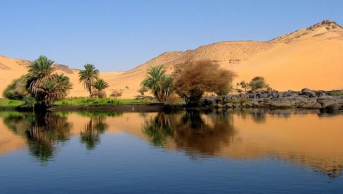September Agreement and Transboundary Water Cooperation in the Nile Basin: Still Not Testing the Limits of Progress

On September 20, 2016, three major riparians of the Nile transboundary river basin, namely Egypt, Ethiopia and Sudan signed a contract to carry out environmental impact studies on Ethiopia's Grand Renaissance Dam (GERD) on the Nile. It became possible after a lengthy and tumultuous process of negotiations and dissent. After 2015’s agreement on the Khartoum Declaration, which laid down a number of general principles, September’s agreement appears to be another milestone in cooperation over Nile issues. It should be noted, nevertheless, some fundamental matters remain to be resolved.
The signing ceremony was in Khartoum, Sudan, where the host country’s Water Resources and Electricity MinisterMutazMussa remarked "We have bigger dreams of regional integration. Our objectives are to generate electricity and to reduce power blackout in all the countries". He continued, saying "I'm confident that our three countries have the necessary expertise to support, validate and approve the two studies report in a joint effort with the consultant." There is always an inflation of expectations in the Nile cooperation attempts which, in time, proved to be nothing more than wishful-thinking.
Egypt's Minister of Water Resources Mohamed Abdel-Ati also sees the agreement as a great step forward:"It is an event that we are witnessing today after long path that we have been through to achieve this stage”. In comparison Muhammad Morsi, Egypt’s Al-Sisi administration adopted a different, more positive view on the Nile. This change of attitude actually paved the way for Khartoum Declaration and this year’s Agreement. However, despite this apparent positive attitude, Egypt’s concerns, to a great extent, continue to be real. Egypt still fears that the GERD would negatively affect its share of the Nile water, which amounts to 55.5 billion cubic meters.
Ethiopia’s well-known argument was reiterated by MotumaBedassa, this country’s Minister of Water, Irrigation and Electricity, "many prior studies have indicators that the GERD can be filled and operated without causing any significant harm to any of the three eastern Nile countries."Ethiopia is basically emphasizing a win-win scenario where a surplus of electricity would be created, and Sudan and Egypt would have priority to buy this electricity. Further, Ethiopians claim that Khartoum Declaration made it possible to compensate damages caused by the Dam in the downstream.
In order to better perceive enduring challenges along the Nile, it can be useful to summarize the history of “who gets what” in the Nile Basin. Hydro-politics in the Nile Basin is a feature of contested interests dating back to colonial period. The first significant Treaty on the sharing of the Nile was signed in 1929 between Egypt and Britain. One of the most notable parts of the Treaty relates to annual water allocations between Egypt and Sudan. According to this, Egypt would receive 48 billion cubicmeters of water, and Sudan would use 4 billion cubic meters of water from the Nile. Another significant point in the 1929 Treaty was Egypt’s veto right: Egypt had veto power over dam projects on the Nile River or any of its tributaries that could have an effect on the flow of water into the Nile. Egypt, which officially became independent in 1922, remained under British influence until 1952, when Free Officers Movement gained control. Therefore, this Treaty should be read as a colonial-era accord where British divided Nile waters among its protectorates. After the Second World War, the decolonization had a profound impact on the Nile issues. Not only Egypt, but also Sudan became independent. In 1959, these two countries signed a bilateral agreement which increased water allocations of both. Egypt’s share was increased to 55.5 billion cubic meters and Sudan’s to 18.5 billion cubic meters. Both 1929 and 1959 treaties did not pay adequate attention to water needs of upstream countries.
Egypt’s -and to some extent- Sudan’s privileged status in the Nile hydro-politics became increasingly untenable after the end of the Cold War in the face of a number of reasons including the rising voices of the ignored riparians, particularly Ethiopia, and maturing of the processes of statehood consolidation in Sub-saharanriparians.
In 1999, the Nile River riparian states, with the exception of Eritrea, signed the Nile Basin Initiative (NBI), a platform based in Entebbe, Uganda aimed increasing the cooperation over “common” Nile Basin water resources.The NBI brought a fresh start to basin-wide transboundary water cooperation in the Nile. The Cooperative Framework Agreement (CFA), which was drafted under the NBI framework was signed in 2010 by Burundi, Ethiopia, Kenya, Rwanda, Tanzania, and Uganda. Ethiopia was the first to ratify it. Egypt and Sudan, on the other hand, argued –referring to earlier agreements- that they had “acquired rights” and the proposed CFA would not be sufficient to protect those rights. Article 14(b) which reads “Nile Basin States therefore agree, in a spirit of cooperation: . . . (b) not to significantly affect the water security of any other Nile Basin State” was a particular source of worry for Egypt and Sudan. They sought an amendment to it so as to include the term “current uses and rights of any other Nile Basin State,”. However, not surprisingly, this wording was rejected by upstreamers, on the grounds that colonial agreements that Egypt and Sudan refer to were inherently unfair.
According to one point of view, the long-lasting step-wise approach to sharing Nile’s transboundary waters did yield little fruit, with Egypt and Sudan largely maintaining their rigid positions. The history above is to show that divergence between Sudan and Egypt on the one hand, and Ethiopia on the other is still deep, and far from being transformed to a point of convergence in the short run. Yet there is another view, an essentially optimistic one, which contends that the chasm between downstream and upstream is gradually disappearing as the technical processes proceeds further. Which argument is more plausible? Time will tell.










